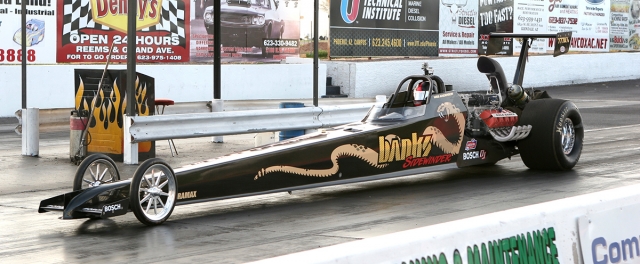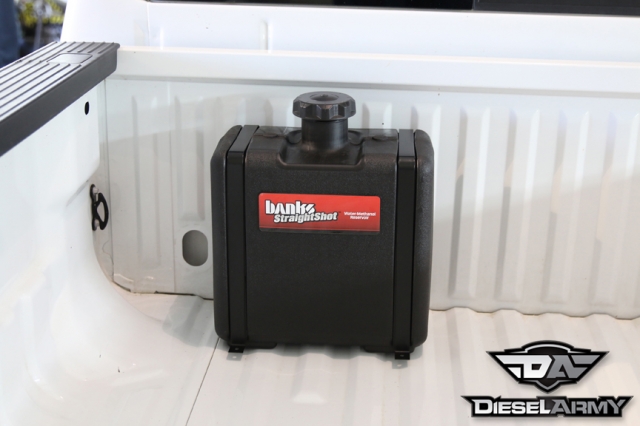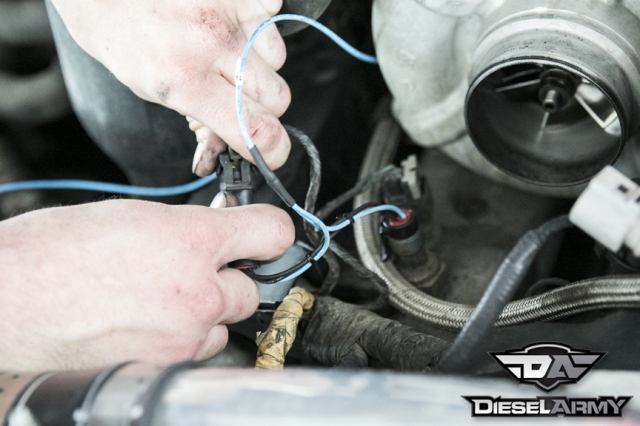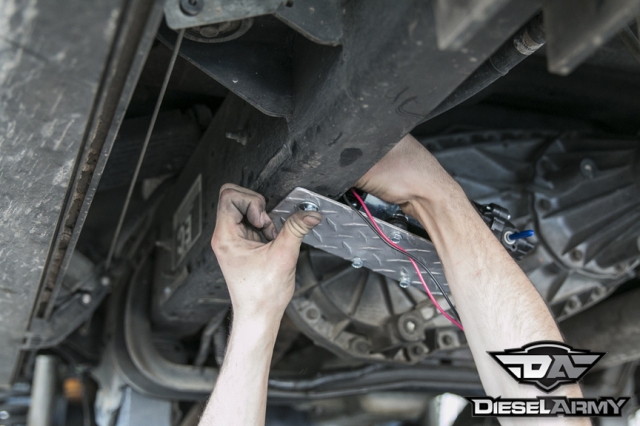Continual improvement is a way of life. As new technologies are created they are adapted to older concepts to continually reinvent what is possible. If you really think about it, it is amazing that something developed over 100 years go, can still be relevant today, but in fact there are a number of things around us that are indeed that old. Or at least they can trace their roots back that far or farther.

Henry Ford’s first automobile, the 1896 Ford Quadricycle. On display in the Henry Ford Museum. Photo courtesy of the Henry Ford Museum.
In fact, one of the things we are most passionate about is a perfect example of that. The first “horseless carriages” started showing up well over 100 years ago and yet here we are, still spending the majority of our life trying to figure out how to improve it. Another technology that is pretty old is water/methanol injection.
After a number of years of research and development, Banks Power, recently released their water/methanol injection system. The advancements they have made demonstrate the continual evolution of water/methanol injection. Before we jump too far ahead of ourselves, let’s first take a look at some basics of water/methanol.
Basics
Water/methanol is a mixture of two key components, water and methanol. (There are other additives like corrosion inhibitors, but they are in very small quantities compared to the water and methanol.) Just like the name suggests. Each of these components does something different; so let’s look at each one.
Water
Water is a very interesting compound that can exist in a multiple phases; solid (ice), liquid and gas/vapor (steam). As liquid water is injected into the system, it begins to absorb heat from the surrounding air. As this heat is removed from the air, the air temperature begins to drop and the liquid water temperature begins to increase. This continues to happen until a point that the liquid water goes under what is called a phase change where it actually no longer is a liquid but become as gas or vapor. During this process, a tremendous amount of heat is removed from the air temperature.
As a result of the reduction of intake temperature, combustion temperatures are lower, resulting in lower exhaust gas temperatures. (To read a more indepth article on how water/methanol injection work, click here.)
Methanol
Methanol is a form of alcohol, but is not the type you drink. It’s a clear liquid that is used as a fuel. It is used in the production of biodiesel and is, also, used widely in many forms of racing. In the form that we’re talking about here with water/methanol injection, the methanol should be looked at as a fuel to add more power to the engine.

This image may look a little strange. We had to adjust the contrast and clarity to show the mist. The Banks Power nozzle does a great job of atomizing the water/methanol.
Uses
“In a diesel application water/methanol injection gives us two primary benefits: the first, of course, is adding power. It is a very functional power adder. We’ve seen additions of up to 175 horsepower depending on applications,” said Peter Treydte, Test Group Manager at Banks Power. The majority of the power that is being added to the engine is from the methanol. The leaner the engine is running, the more power will be generated from the methanol.
The secondary benefit is in the cooling of exhaust gas temperatures – Peter Treydte
What makes the Banks Power system great?
Water/methanol injection systems are controlled by regulating the water/methanol injection pump. The rest of the system will flow whatever volume of fluid is being moved through. So, in the earliest of water/methanol systems, the pumps were controlled with a basic on/off switch. At whatever point the system was set to come on (whether that is a certain boost level or EGT or what have you) the injection pump would kick on and start pumping the maximum amount of water/methanol into the engine.
In both those cases, you can never quite match what the engine demand is – Peter Treydte
Realizing that the engines were either over supplied or under supplied, Banks Power developed a system to better control the injection pump through a progressive controller. “We can control pump duty cycle from basically 25% up to 100%, but it’s fully adjustable. We can tailor the curve to whatever the operating conditions might be. Our current iteration has four control points. We can actually adjust the curve based on those four control points. Say, I set my starting boost at 7 pounds of boost and the ending point at 30 pounds of boost at 100% duty cycle. With those control points, I can draw a sloped line. Now, I can put extra points in the middle to really shape the curve to match the engine’s demand. That is really the key point. You really want to be able to match the demand coming from the engine. The engine operation is dynamic, so we want the fluid to match with the engine’s demand. With a step function, you can never quite match the engine demand. So it’s really the ability to design the curve to match the delivery that is so important,” continued Treydte.
So, do I have to be an engineer to set this thing up?

The user interface is the same size as a standard gauge. This make it very easy to mount and with only two buttons, it is fairly easy to use. You will probably need to read the instructions to initially set the system up. After that, there is very little input required from the driver.
“The system is delivered with some default set points, but we, also, provide information for your individual application so you can set the system up for your application. In a diesel application this is primarily driven by horsepower level. The more dramatic the horsepower output is, the more aggressive you can be with the system. With a diesel or any boosted application, usually the best method of control is a boost reference. Boost is generally a good indicator of airflow into the engine. We can, also, control off of EGT’s and throttle position. Throttle position is used mostly for gas applications,” continued Treydte.
I tow heavy loads, how can this help me?
When towing there are really three primary reason to use water/methanol: the need to cool your EGT’s, the need for more power to go up a hill or a combination of both.
 “Let’s define the problem statement: it’s the middle of summer and you are driving up a grade. The EGT’s are high, so you have to back out of the throttle because you are concerned about your exhaust gas temperatures. In this situation the best solution is water injection,” pointed out Treydte
“Let’s define the problem statement: it’s the middle of summer and you are driving up a grade. The EGT’s are high, so you have to back out of the throttle because you are concerned about your exhaust gas temperatures. In this situation the best solution is water injection,” pointed out Treydte
“The next problem statement; I need more power to make it up the grade. That is when you want to use water/methanol. In this scenario, we are generally seeing about 100 horsepower addition with water/methanol. It’s a nice comfortable power gain for these types of situations,” explained Treydte.
“Finally, I need more power, but my EGT’s are already pretty high. We have found in certain circumstances; water/methanol can help cool EGT’s while increasing power levels. If you use it moderately there are some cooling benefits. If you use it aggressively, you can get higher EGT’s because the methanol is a fuel,” continued Treydte
Banks Power recommends using distilled water if you plan on using a straight water injection. If you are looking at adding more power, but don’t want to run a 50/50 blend, diluting the mixture is an option. When diluting the mixture or running straight water; Banks Power does recommend using some sort of corrosion inhibitor. “Methanol can be corrosive over time,” Treydte pointed out.
If you’re in a situation where you need more water/methanol and don’t have access to banks power blend 50-50 mix than what a lot of guys will do is run some sort of windshield washer fluid. One thing to keep in mind is not all windshield washer fluid has methanol. If you are looking to add windshield washer fluid to the system, just make sure you check the label to ensure that it is a methanol mix and not something else.
I just want more power!
Well, lucky for you, adding more power is pretty easy and generally considered safe with water/methanol injection. The methanol is a fuel and adding more fuel can certainly result in more power. The Banks Power water/methanol kits are available in single or dual stage.
“The distinction between the single and the dual stage is essentially the required demand or how much do we actually need. In most situations for the average diesel pickup truck, running the Double-Shot is the preferred method because it gives us a little more flexibility. For most gasoline applications and smaller diesel applications like a Jetta, the Straight-Shot should be sufficient,” explained Treydte.
The distinction between the single and the dual stage is essentially the required demand– Peter Treydte
With that in mind, we decided to install the Banks Power Double-Shot on our 2008 Ford F-250. While this truck is lifted and looks pretty, it, also, sees a wide range of uses. The owner regularly tows, races and generally raises hell with his truck. Being over fueled, it doesn’t take much for the EGTs to get out of control. We are interested in the power gains, but mostly being able to control the EGTs (especially when towing).
Down To Business
We took the truck down to Diesel Dynamics in Joshua, Texas to have them install the kit and dyno the truck. MacLain Young was kind enough to walk us through the installation of the Banks Power Double-Shot system (part number 45181). Young likes to lay everything out and figure out where the key components are going to mount before he starts to worry about routing the wiring and plumbing.
By knowing where everything is going to be mounted, Young can ensure that the wires are cut to the appropriate length and that the installation can be as clean as possible. He started with just setting the water/methanol reservoir in the bed of the truck.
 The injection pump can really be mounted anywhere along the frame. Since the truck was already equipped with A-Pillar gauges, Young opted to mount the controller on the center console. The key here was to find the right angle, so the driver could read the controller.
The injection pump can really be mounted anywhere along the frame. Since the truck was already equipped with A-Pillar gauges, Young opted to mount the controller on the center console. The key here was to find the right angle, so the driver could read the controller.
After Young decided on where he was going to mount the controller, he drilled a hole in the bottom of the center console to run the wiring for the controller. Then the wiring was fed under the center console and up through the hole. The remaining wiring was fed through the firewall.
 The wiring that goes to the pump was dropped down under the cab of the truck, for later installation. The power wires were run to the battery, the map sensor wiring was laid over the cowl and the solenoid wiring was laid over the fender (grouping like wiring makes it easy to keep track of what is what).
The wiring that goes to the pump was dropped down under the cab of the truck, for later installation. The power wires were run to the battery, the map sensor wiring was laid over the cowl and the solenoid wiring was laid over the fender (grouping like wiring makes it easy to keep track of what is what).
To get access to the MAP (boost) sensor, the intake was removed and the wiring was connected in line with the factory wiring (no cutting necessary). Young then drilled a few holes in the cowl, so he could use zip ties to hold the wires and water lines up and out of the way.
With the power wires run and the MAP sensor hooked up, Young turned his attention to the injection pump. He cut a mounting plate out of aluminum diamond plate and mounted the pump to it. From there, he ran the pump wires under the cab and along the frame to just behind the transfer case. Using a pair of vice grips to hold the pump and plate into place, he drilled a couple holes in the frame and bolted the assembly to the frame. Once the pump was mounted to the frame, he simply connected the wiring.
 Young then turned his attention to the plumbing. He ran the supplied Nylon tubing from the reservoir tank to the injection pump and from the pump up to the engine compartment.
Young then turned his attention to the plumbing. He ran the supplied Nylon tubing from the reservoir tank to the injection pump and from the pump up to the engine compartment.
With the solenoid wiring still hanging over the fender and the water/methanol tubing now in the engine compartment, Young could start planning his attack on mounting the solenoid and running the injection lines. Young decided to use the factory studs on the fire wall to mount the solenoid. While not the easiest of places to access, it certainly kept the installation looking very clean and out of the way.
Next, Young routed the water lines up and over the engine and then over to the intake elbow. With the lines running how he wanted them, he marked where he wanted to install the water nozzles on the intake.
With the mounting locations marked, he removed the intake only to reveal a potential issue. The elbow that is on the truck is an aftermarket elbow made out of pretty thin wall tubing. Instead of having a panic attack, he talked to a few of the other techs and learned a really cool trick.
If you drill a hole much smaller than you need and then dimple the whole to the desired size, you can thread thin wall tubing. By dimpling the tube, you are essentially creating more material for the threads to hold on to (almost like increasing the thickness of the tubing in that one spot.) After the elbow was dimpled, the threads were cut and the nozzles were installed with thread sealant. From there, the elbow was re-installed.
To connect the Nylon hoses to the nozzles, the supplied 90 degree fittings were installed and then the hoses connected. Note, the primary nozzle is connected directly to the injection pump (an anti-siphon check valve must be installed for vehicles using throttle bodies.) The other hose is connected to a solenoid and doesn’t require a anti-siphon valve because the solenoid prevents flow when off.
The last major component to be hooked up is the EGT sensor. Young rolled under the truck, found a good location to mount the probe (most of the time, the EGT probes are mounted on the driver’s side exhaust manifold just before the elbow/up pipes) and drilled a pilot hole.
After the pilot hole was drilled into the exhaust manifold, he followed it up with a larger hole. This puts less stress on the exhaust manifold as well as the bits. From there, he slowly threaded the manifold and then screwed in the probe. The wiring for the probe was run up into the cab and connected to the controller as well.
Once the system was full hooked up, Young filled the reservoir mounted in the truck with some of the Banks PowerBlend.
Tuning the system does require going through a few screens to get to the right setting, but the instructions are very clear and specific on what is needed. Young was able to dial in the initial setting pretty easy and he was ready to prime the system.
Getting a little help from a friend, they unhooked the water/methanol lines running to the intake and held them in the empty PowerBlend container. From there, Young followed the prompts and bled the system.
The Pay Off
 The truck was backed out of the bay and driven over to the dyno. Multiple pulls were made to get a good baseline on the horsepower and torque number. The truck has had quite a few engines in it over the past 300,000 miles and we wanted to make sure we were getting a repeatable number. With the truck running a tow tune, it was laying down anywhere from 423 horsepower to 430. The torque was pretty consistent too, peaking out at 1155 lb-ft of torque plus or minus 10 lb-ft.
The truck was backed out of the bay and driven over to the dyno. Multiple pulls were made to get a good baseline on the horsepower and torque number. The truck has had quite a few engines in it over the past 300,000 miles and we wanted to make sure we were getting a repeatable number. With the truck running a tow tune, it was laying down anywhere from 423 horsepower to 430. The torque was pretty consistent too, peaking out at 1155 lb-ft of torque plus or minus 10 lb-ft.
From there, we turned the system on and let her go. We ended up seeing a peak gain of 81 horsepower and 133 lb-ft of torque. These gains are good but really don’t tell the story of the difference.
We then took the data and looked at horsepower and torque every 50 rpm. Here is where the real difference lies.
Torque
The truck produced over 100 lb-ft of torque more from 1,000 rpm to 3,100 rpm when Young let off. There was actually a peak increase of 308 lb-ft of torque at 1,950 rpm. If you look at the graph below, you will notice from just about 1,700 rpm to 2,700 rpm (the common RPM when towing) the Banks Power water/methanol injection system was producing at least 200 lb-ft of torque more. That will certainly make a difference climbing a hill, passing a vehicle, or merging onto the freeway.
Horsepower
On the horsepower side of things, the story is pretty impressive as well. From 1,800 rpm to 3,000 rpm the water/methanol was adding over 80 hp. In fact, at 1,900 rpm, there was a peak increase of 103 hp. So, while peak to peak horsepower gains showed 81 horsepower on the dyno graph, in fact the largest gain was 103 hp.
Data
| RPM | Baseline Horsepower | Double-Shot Horsepower | Horsepower Increase | Baseline Torque | Double-Shot Torque | Torque Increase | |
|---|---|---|---|---|---|---|---|
| 1000 | 215.8 | 236.6 | 20.8 | 1133.4 | 1242.8 | 109.4 | |
| 1050 | 229.3 | 252.2 | 22.9 | 1147.1 | 1261.6 | 114.5 | |
| 1100 | 241.7 | 266.9 | 25.2 | 1154.2 | 1274.2 | 120.0 | |
| 1150 | 253.1 | 280.9 | 27.8 | 1155.8 | 1283.1 | 127.3 | |
| 1200 | 263.5 | 294.3 | 30.8 | 1153.2 | 1288.2 | 135.0 | |
| 1250 | 273.0 | 306.8 | 33.8 | 1147.2 | 1288.9 | 141.7 | |
| 1300 | 282.1 | 318.5 | 36.4 | 1139.6 | 1286.9 | 147.3 | |
| 1350 | 290.7 | 329.6 | 38.9 | 1131.1 | 1282.5 | 151.4 | |
| 1400 | 299.3 | 340.2 | 40.9 | 1122.7 | 1276.1 | 153.4 | |
| 1450 | 307.5 | 350.2 | 42.7 | 1114.0 | 1268.3 | 154.3 | |
| 1500 | 315.7 | 359.9 | 44.2 | 1105.4 | 1260.0 | 154.6 | |
| 1550 | 323.1 | 369.2 | 46.1 | 1094.7 | 1251.1 | 156.4 | |
| 1600 | 328.9 | 378.5 | 49.6 | 1079.5 | 1242.6 | 163.1 | |
| 1650 | 332.5 | 387.7 | 55.2 | 1058.2 | 1234.1 | 175.9 | |
| 1700 | 332.9 | 396.7 | 63.8 | 1028.5 | 1225.5 | 197.0 | |
| 1750 | 330.5 | 405.1 | 74.6 | 991.8 | 1215.9 | 224.1 | |
| 1800 | 325.8 | 412.9 | 87.1 | 950.8 | 1204.8 | 254.0 | |
| 1850 | 322.0 | 419.4 | 97.4 | 914.0 | 1190.6 | 276.6 | |
| 1900 | 321.5 | 424.6 | 103.1 | 888.7 | 1173.8 | 285.1 | |
| 1950 | 325.3 | 428.5 | 103.2 | 846.0 | 1154.0 | 308.0 | |
| 2000 | 331.8 | 431.6 | 99.8 | 871.5 | 1133.5 | 262.0 | |
| 2050 | 340.6 | 434.8 | 94.2 | 872.7 | 1113.9 | 241.2 | |
| 2100 | 350.2 | 439.0 | 88.8 | 875.9 | 1097.9 | 222.0 | |
| 2150 | 359.0 | 444.7 | 85.7 | 877.0 | 1086.2 | 209.2 | |
| 2200 | 366.7 | 451.9 | 85.2 | 875.5 | 1078.8 | 203.3 | |
| 2250 | 373.3 | 459.8 | 86.5 | 871.3 | 1073.3 | 202.0 | |
| 2300 | 379.1 | 467.7 | 88.6 | 865.8 | 1067.9 | 202.1 | |
| 2350 | 384.2 | 475.0 | 90.8 | 858.6 | 1061.5 | 202.9 | |
| 2400 | 388.9 | 481.4 | 92.5 | 851.1 | 1053.5 | 202.4 | |
| 2450 | 392.5 | 487.2 | 94.7 | 841.4 | 1044.4 | 203.0 | |
| 2500 | 395.7 | 492.6 | 96.9 | 831.3 | 1034.8 | 203.5 | |
| 2550 | 399.4 | 497.7 | 98.3 | 822.5 | 1025.1 | 202.6 | |
| 2600 | 402.9 | 502.2 | 99.3 | 813.9 | 1014.5 | 200.6 | |
| 2650 | 406.0 | 505.8 | 99.8 | 804.7 | 1002.4 | 197.7 | |
| 2700 | 408.5 | 508.2 | 99.7 | 794.6 | 988.5 | 193.9 | |
| 2750 | 409.6 | 509.9 | 100.3 | 782.3 | 973.9 | 191.6 | |
| 2800 | 412.0 | 510.8 | 98.8 | 772.8 | 958.2 | 185.4 | |
| 2850 | 416.6 | 511.2 | 94.6 | 767.7 | 942.0 | 174.3 | |
| 2900 | 419.2 | 510.5 | 91.3 | 759.2 | 924.6 | 165.4 | |
| 2950 | 420.8 | 510.7 | 89.9 | 749.2 | 909.3 | 160.1 | |
| 3000 | 424.3 | 511.2 | 86.9 | 742.9 | 894.9 | 152.0 | |
| 3050 | 427.8 | 505.9 | 78.1 | 736.8 | 872.2 | 135.4 | |
| 3100 | 427.3 | 491.9 | 64.6 | 724.0 | 833.4 | 109.4 | |
| 3150 | 427.7 | 713.2 | |||||
| 3200 | 430.3 | 706.2 |
Bottom line
With this installation being photographed and it was Young’s first time installing this kit, it took him 5 hours. So, this is easily a kit that someone can do themselves over a weekend really without worrying about downtime. The only two times the truck would have been down was when the intake elbow was being tapped and the exhaust manifold was being drilled. Outside of that, the truck could have been started and driven at any point.
Whether you are looking to keep your EGTs under control, looking for more power, or looking to increase your mileage, a Double-Shot water/methanol kit is a great option.














































